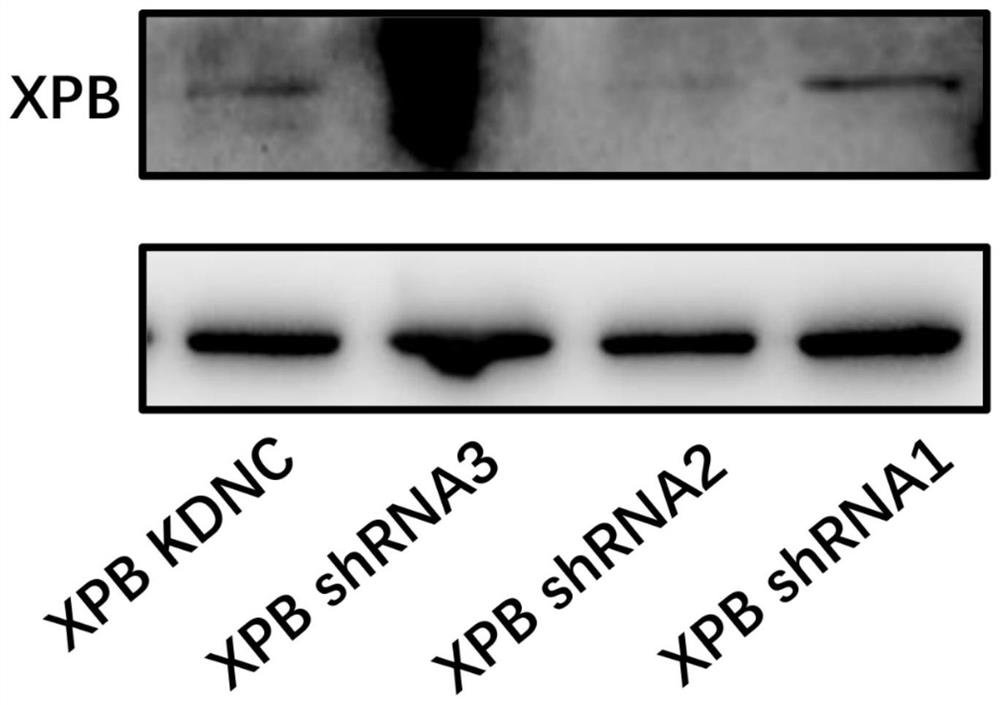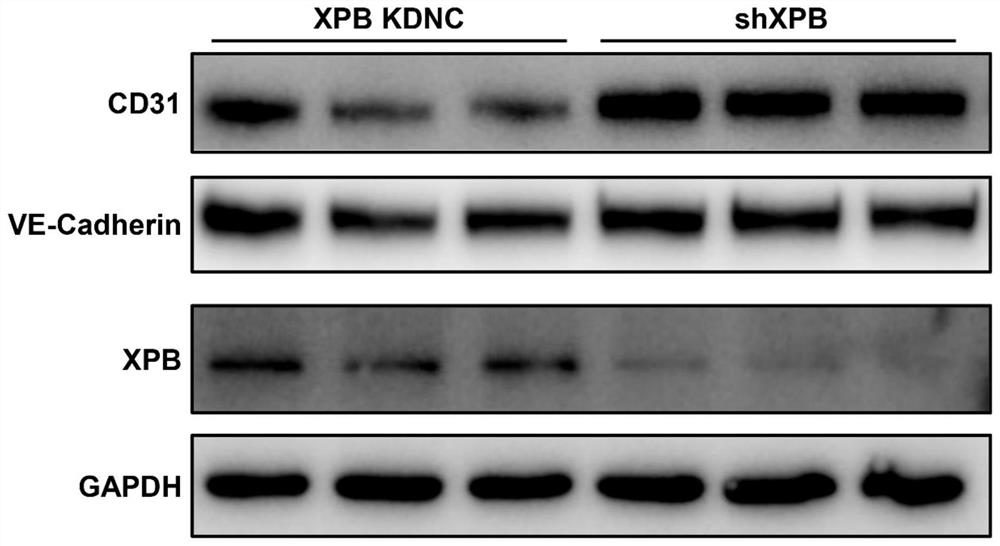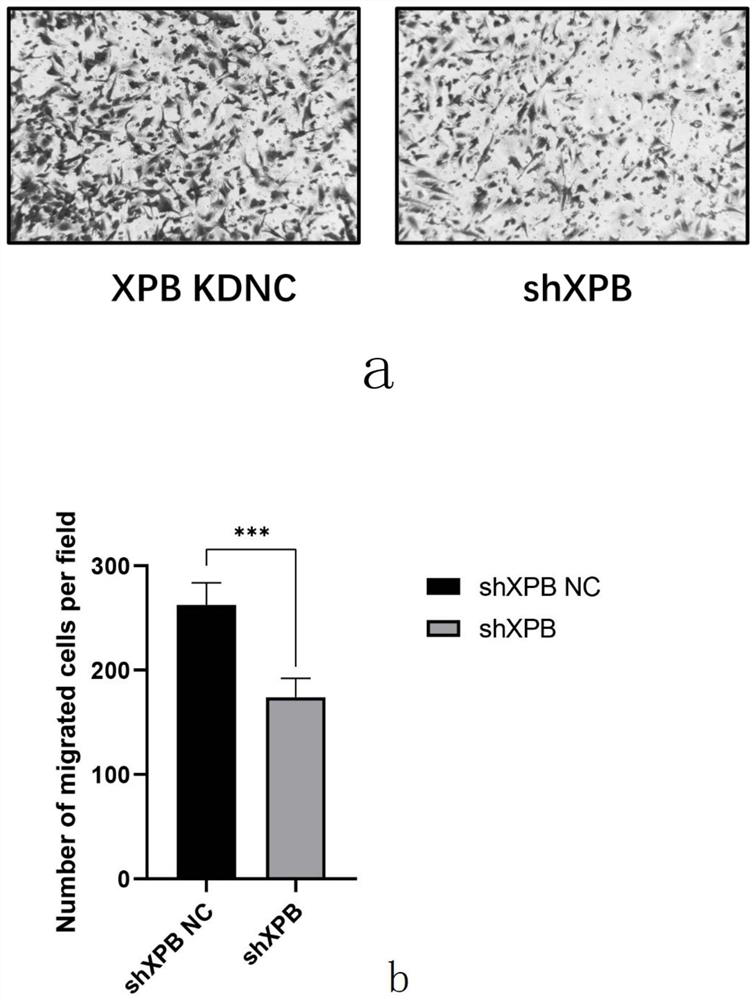Substance for inhibiting XPB expression and endothelial cell line with XPB low expression
An endothelial cell, low expression technology, applied in the fields of medical molecular biology and genetic engineering, to achieve the effect of improving and inhibiting endothelial mesenchymalization
- Summary
- Abstract
- Description
- Claims
- Application Information
AI Technical Summary
Problems solved by technology
Method used
Image
Examples
preparation example Construction
[0076] The present invention also provides a method for preparing a recombinant lentiviral expression vector, comprising the following steps:
[0077] Step 1: annealing the single-stranded DNA molecule shown in SEQ ID NO: 11 and the single-stranded DNA molecule shown in SEQ ID NO: 12 to form a DNA double-stranded fragment with sticky ends;
[0078] Step 2: The lentiviral vector pHBLV-U6-MCS-PGK-NEO was digested by restriction endonuclease 1 and restriction enzyme 2, and the DNA double-stranded fragment obtained in step 1 was connected by T4 ligase vector to obtain a recombinant lentiviral vector.
[0079] The present invention also provides a method for constructing a microvascular endothelial cell line with low expression of XPB, comprising the following steps:
[0080] Step 1: Combining the recombinant lentiviral vector with the viral packaging auxiliary plasmids pSPAX2 and pMD2G to form a three-plasmid lentiviral system for viral packaging, and then transfecting 293T cells...
Embodiment 1
[0113] Example 1. Design and synthesis of siRNA targeting XPB gene mRNA (referred to as XPB siRNA)
[0114] The inventor of the present invention designs the siRNA targeting XPB gene by searching the sequence of human XPB in the NCBI GenBank database (www.ncbi.nlm.nih.gov / gene), and the design mainly follows the following principles: (1) In The cDNA of XPB is designed around 50-100 nt downstream of the initiation codon (AUG), and avoids non-coding regions such as introns, 5'UTR, 3'UTR; (2) avoids more than 4 identical bases and SNP single nucleotide polymorphism sites; (3) try to control the content of G and C bases between 30% and 60%; (4) carry out homology alignment after the design is completed.
[0115] Following the above principles, three pairs of XPB siRNA were designed and named as XPB siRNA1, XPB siRNA2 and XPBsiRNA3. The sense and antisense strands of 3 pairs of XPB siRNA were synthesized by Sangon Bioengineering (Shanghai) Co., Ltd. siRNA NC was donated by Sangon...
Embodiment 2
[0120] Example 2. Construction of lentiviral vector targeting XPB gene and identification of its interference effect on XPB gene
[0121] 1. Construction of XPB shRNA and shRNA NC recombinant lentiviral vectors
[0122] (1) Determine the interference target and design and synthesize primers
[0123] Short hairpin RNAs (shRNAs) were designed based on XPB siRNA1, XPB siRNA2 and XPB siRNA3, respectively.
[0124] ① Design a short hairpin RNA (XPB shRNA1) sequence based on the XPB siRNA1 sequence and synthesize primers. The upstream primer is: 5'-GATCCGCCTTCTCTCCAGTTTACAAATATGCTCGAGCATATTTGTAAACTGGAGAGAAGGCTTTTTTG-3' (SEQ ID NO: 9), and the downstream primer is: 5'-AATTCAAAAAAGCCTTCTCCAGTTTACAAATATGCTCGAGCATATTTGTAAACTGGAGAGAAGGCG-3' (SEQ ID NO: 10);
[0125] ② Design and synthesize short hairpin RNA (XPB shRNA2) sequence based on XPB siRNA2 sequence and synthesize primers. The upstream primer is 5'-GATCCGCCAAGACTTCTTGGTGGCTATTGCACTCGAGTGCAATAGCCACCAAGAAGTCTTGGTTTTTTG-3' (SEQ ID...
PUM
 Login to View More
Login to View More Abstract
Description
Claims
Application Information
 Login to View More
Login to View More - R&D
- Intellectual Property
- Life Sciences
- Materials
- Tech Scout
- Unparalleled Data Quality
- Higher Quality Content
- 60% Fewer Hallucinations
Browse by: Latest US Patents, China's latest patents, Technical Efficacy Thesaurus, Application Domain, Technology Topic, Popular Technical Reports.
© 2025 PatSnap. All rights reserved.Legal|Privacy policy|Modern Slavery Act Transparency Statement|Sitemap|About US| Contact US: help@patsnap.com



